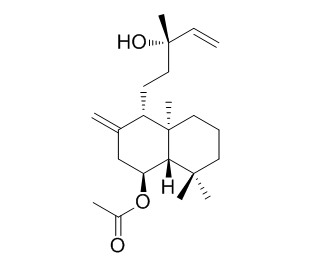Larixyl acetate
Larixyl acetate exhibits analgesic and anti-inflammatory action in neuropathic pain, the action involves the suppression of TRPC6 and p38 signaling in the microglia.
Inquire / Order:
manager@chemfaces.com
Technical Inquiries:
service@chemfaces.com
Tel:
+86-27-84237783
Fax:
+86-27-84254680
Address:
1 Building, No. 83, CheCheng Rd., Wuhan Economic and Technological Development Zone, Wuhan, Hubei 430056, PRC
Providing storage is as stated on the product vial and the vial is kept tightly sealed, the product can be stored for up to
24 months(2-8C).
Wherever possible, you should prepare and use solutions on the same day. However, if you need to make up stock solutions in advance, we recommend that you store the solution as aliquots in tightly sealed vials at -20C. Generally, these will be useable for up to two weeks. Before use, and prior to opening the vial we recommend that you allow your product to equilibrate to room temperature for at least 1 hour.
Need more advice on solubility, usage and handling? Please email to: service@chemfaces.com
The packaging of the product may have turned upside down during transportation, resulting in the natural compounds adhering to the neck or cap of the vial. take the vial out of its packaging and gently shake to let the compounds fall to the bottom of the vial. for liquid products, centrifuge at 200-500 RPM to gather the liquid at the bottom of the vial. try to avoid loss or contamination during handling.
Separations2021, 8(1), 1.
Biol Pharm Bull.2018, 41(11):1645-1651
Asian Pac J Cancer Prev.2019, 20(1):65-72
Biomolecules.2019, 9(11):E696
J Appl Biol Chem.2022, 65(4):pp.463-469.
World J.Traditional Chinese Med.2024, 10(3):370-382
Plant Sci.2020, 301:110656.
Journal of Holistic Integrative Pharmacy2024, 5(1):45-55.
Nutrients.2024, 16(20):3521.
BMC Plant Biol.2021, 21(1):60.
Related and Featured Products
Journal of Neuroinflammation, 2020, 17(1).
The analgesic action of larixyl acetate, a potent TRPC6 inhibitor, in rat neuropathic pain model induced by spared nerve injury.[Reference:
WebLink]
Neuropathic pain is a debilitating status that is insusceptible to the existing analgesics. It is important to explore the underlying pathophysiological changes and search for new pharmacological approaches. Transient receptor potential canonical 6 (TRPC6) is a mechanosensitive channel that is expressed by dorsal root ganglia and glial cells. It has been demonstrated that this channel in dorsal root ganglia plays essential roles in the formation of mechanical hyperalgesia in neuropathic pain. Recent pharmacological screening suggests that Larixyl acetate (LA), a main constituent of larch resin, is able to selectively inhibit TRPC6 function. But whether LA is effective in treating neuropathic pain remains unknown. We investigated the efficacy of LA in rat neuropathic pain model, examined its effects on central neuroinflammation, and explored the possible molecular mechanisms by targeting the spinal dorsal horn.
Journal of Wood science., 01 Oct 2012, 58(5):437-445.
Accumulation of constitutive diterpenoids in the rhytidome and secondary phloem of the branch bark of Larix gmelinii var. japonica.[Reference:
WebLink]
The quantitative compositions of the major constitutive diterpenoids in the rhytidome and secondary phloem of the branch bark of Kuril larch (Larix gmelinii var. japonica) were investigated.
METHODS AND RESULTS:
The eight major diterpenoids were isolated from a diethyl ether extract of the branch bark of L. gmelinii var. japonica and identified as 13-epimanool (1), larixol (2), Larixyl acetate (3), 13-epitorulosyl acetate (4), abietic acid (5), neoabietic acid (6), dehydroabietic acid (7), and isopimaric acid (8). The amount of each diterpenoid was subsequently quantified in both the rhytidome and secondary phloem. All of the diterpenoids were present in both bark tissues, but the amounts were significantly higher in the rhytidome than in the secondary phloem. Developed fusiform resin cavities containing oleoresins were commonly observed in dead secondary phloem captured into the rhytidome of a bark transverse section. The accumulation and distribution of these constitutive diterpenoids in the bark tissues can probably be attributed to terpenoid biosynthesis in the living secondary phloem and the rhytidome formation process.
CONCLUSIONS:
From the viewpoint of constitutive chemical defense in conifers, it is suggested that the tree body may be more effectively defended against natural enemies by the higher amount of diterpenoid amount in the outermost and dead bark tissue, the rhytidome, where the potentially poisonous and easily oxidizable diterpenoids can be safely and stably maintained.



